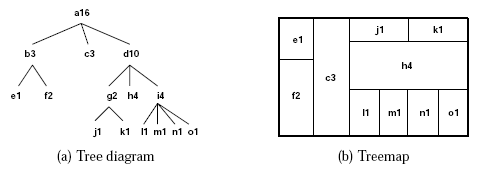Baobab
Treemap concepts have been developed by Ben Shneiderman in the '90s. Read his vision on treemaps.
Figure shows an example of treemap's theory. Each node (as shown in the tree diagram) has a name (a letter) and an associated size (a number). The size of leaves may represent for instance the size of individual files, the size of non-leaf nodes is the sum of the sizes of its children.
The treemap is constructed via recursive subdivision of the initial rectangle. The size of each sub-rectangle corresponds to the size of the node. The direction of subdivision alternates per level: first horizontally, next vertically, etcetera. As a result, the initial rectangle is partitioned into smaller rectangles, such that the size of each rectangle reflects the size of the leaf. The structure of the tree is also reflected in the treemap, as a result of its construction. Color and annotation can be used to give extra information about the leaves.
![[Note]](images/admin/note.png)
|
|
|
Treemaps are very effective when size is the most important feature to be displayed. |



